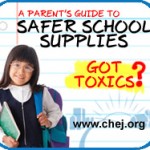Aaahhh…September is right around the corner. September signals summer slowly winding to an end, and for many adults, signals a renewed sense of purpose. I think many of us “grown-ups” regard September as a kind of “New Year” as we are so used to associating this month with the start of a new school year. So, in the spirit of my pseudo holiday, I have decided to take on a September New Year’s Resolution - I hereby resolve to send my sons back to school with PVC-free school supplies.

PVC, polyvinyl chloride, has been notoriously deemed the “poison plastic” for good reason. Polyvinyl Chloride (PVC) is unique among plastics because it contains dangerous chemical additives used to soften or stabilize it. These harmful chemicals include phthalates, lead, cadmium, and/or organotins. One could argue that no other plastic contributes to the release of as many reproductive health toxicants than PVC. PVC’s lifecycle is one of the largest sources of dioxins in our environment. Exposure to dioxin has been linked with birth defects, decreased fertility, inability to carry pregnancies to term, lowered testosterone levels, decreased sperm counts, and decreased testis size. Furthermore, several studies have detected measureable amounts of dioxin in women's breastmilk.
Additionally, PVC is responsible for the consumption of over 90% of all phthalates worldwide. Phthalates must be added to PVC in large quantities – and can make up to 60% of the final product by weight. Over 5 million tons of phthalates are used in vinyl every year, and more than 80 million tons of phthalates are estimated to be contained in the stock of PVC products now in use in buildings and other applications. Exposure to phthalates has been linked to reproductive problems including shorter pregnancy duration, premature breast development in females and sperm damage and impaired reproductive development in males.
You may be thinking to yourself, “Yes, PVC is bad, but what on earth does PVC have to do with school supplies?” Parents across the country are getting ready to stock up on binders and lunchboxes, and while it’s easy to know the healthiest foods to pack in those lunchboxes, many parents are not aware of the toxic plastic used to make them. In fact, the average child’s character-themed backpack is filled with supplies and materials made from toxic PVC. Lunchboxes, binders, vinyl backpacks, and even art supplies are frequently made out of PVC. (more…)




 shouldn’t be inhaled! As that is pretty much impossible to avoid, opt for a wig instead.
shouldn’t be inhaled! As that is pretty much impossible to avoid, opt for a wig instead.


